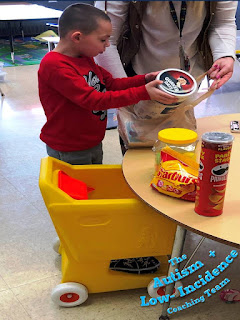Carla shared, "Simply created out of necessity during covid, but have kept the structure of my groups the same ever since. I would not put myself in the “tech savvy” category. So basically, if I can do this, anyone can! The slides became a very structured and predictable way to present groups to my students. It also helped me in not having to plan something different every single week. I create 2 groups (k-2; 3-5); however, the theme is the same for both groups. Once a “theme” is established, the only slides that change are the story and special activity. We sing the same song every week to greet, talk about how we are feeling for the day, then based on the theme, we have signing time, a story, and a special activity (typically a craft). If we are lucky enough to have time left over, someone gets to pick the movement song to finish the group. I also created a binder for the students to follow along and/or provide a way for my nonverbal kiddos to respond."




Individualized Supports for Students
Carla shared, "A student who had significant communication delays and a significant visual impairment came onto my caseload recently. Through research, I came across this 3D tactile communication system geared for students with significant disabilities (those not using speech, sign language, or symbols to communicate). They provide files that can be printed of the symbols you want to target. The files given are for 36 words in the Universal Core vocabulary. The symbols are three-dimensional (3D) symbols that are printed with a different shape, texture and color to indicate the word category. Each symbol includes a unique raised element, the printed word and braille to make the individual word. More information can be found here: https://www.project-core.com/ about-project-core/"
"I created a few object schedule pieces for a student who had increased anxiety about transitioning between environments and activities. The objects provided a symbol-based communication system for him. The objects chosen were considered to be enjoyable and rewarding for him. The object symbols provided him with predictability in his transitioning to the next activity, gave him the ability to make choices, which decreased his anxiety and allowed him to know what was happening next in his routine."
Core Boards
Carla shared, "I recently added a large poster board to a classroom of nonverbal students. A poster is very visible and allows for AAC to be constantly available for all students to use throughout the day. It also allows for the teacher to model when presenting to the class during groups and/or special activities. The core boards are also on the students desks for easy accessibility. Benefits of having a poster core board are: you can use with students that do not yet have their own AAC system, you can model on these communication boards when the AAC user doesn’t want you to use their AAC, and the student can use the board when their AAC device is not charged, broken or unavailable."
Whole class core board for modeling:
"Don't Leave Home Without Them!" Visual Supports
Carla shared these as her "Don't leave home without them" visuals! They provide structure and predictability for all students. They are used in a variety of settings (therapy, classroom, & home) with all ages of students, preschool through adulthood. Visuals allow for less auditory (which can be super difficult because we all like to talk) and provide a sequence of events for the student to be able to recognize and understand. When the ACT team is out to observe, it is evident that these tools are used consistently and effectively!
Carla is a great advocate for our favorite strategies so we are always happy when she is part of the team! She works hard to teach her students functional communication skills and collaborates with the educational team to be sure these skills can transfer across settings. Thanks for all you do, Carla!
Carla is a great advocate for our favorite strategies so we are always happy when she is part of the team! She works hard to teach her students functional communication skills and collaborates with the educational team to be sure these skills can transfer across settings. Thanks for all you do, Carla!




























